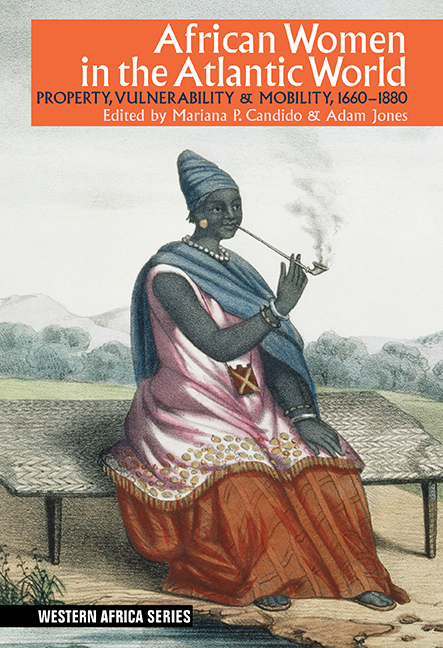Book contents
- Frontmatter
- Contents
- Acknowledgements
- List of Illustrations
- Contributors
- Map 1 Western Africa
- Introduction
- Part One Property
- Part Two Vulnerability
- Part Three Mobility
- 9 From Child Slave to Madam Esperance One Woman's Career in the Anglo-African World c. 1675–1707
- 10 Writing the History of the Trans-african Woman in the Revolutionary French Atlantic
- 11 Spouses & Commercial Partners Immigrant Men & Locally Born Women in Luanda 1831–1859
- 12 Women, Family & Daily Life in Senegal's Nineteenth- Century Atlantic Towns
- Bibliography
- Index
10 - Writing the History of the Trans-african Woman in the Revolutionary French Atlantic
from Part Three - Mobility
Published online by Cambridge University Press: 26 March 2019
- Frontmatter
- Contents
- Acknowledgements
- List of Illustrations
- Contributors
- Map 1 Western Africa
- Introduction
- Part One Property
- Part Two Vulnerability
- Part Three Mobility
- 9 From Child Slave to Madam Esperance One Woman's Career in the Anglo-African World c. 1675–1707
- 10 Writing the History of the Trans-african Woman in the Revolutionary French Atlantic
- 11 Spouses & Commercial Partners Immigrant Men & Locally Born Women in Luanda 1831–1859
- 12 Women, Family & Daily Life in Senegal's Nineteenth- Century Atlantic Towns
- Bibliography
- Index
Summary
The story of Anne Rossignol, a woman of colour from Gorée, Senegal, in West Africa who made her first voyage across the Atlantic to Lorient, France in 1736 as a free girl, sounds like the beginning of a piece of fantastic fiction. The trip from Gorée to Lorient would have been wondrous and maybe frightening for a child. Given her peculiar circumstances, that initial crossing must have been awkward – for those travelling with her. At the time, Anne Rossignol accompanied her French father, Claude Rossignol, and his French wife, Renée Le Monier. For the entire trip, Le Monier would have been confronted with her husband's transgression in the light brown face of Anne whom Claude Rossignol listed as a ‘little mulâtresse, [his] natural daughter’.
It is unclear when Anne Rossignol returned to Gorée. However, she was living there with her own children by the 1750s, appearing in census reports as a signare (‘lady’ derived from Portuguese senhora). When she departed Gorée in the 1770s to make a new life for herself and two of her children in Le Cap in the French colony of Saint-Domingue, Rossignol could not have guessed how the world would explode in 1789. Having lived with great privilege but also the potential threat of vulnerability, Rossignol died at a ripe old age in 1810 in Charleston, South Carolina. Her descendants’ squabbles over an enslaved family Rossignol had owned allowed her to enter the written record for a final time. The fragments of her story that appear in the archive capture a range of complexities about identity, gender, and belonging shared by many other women and men of colour living in the world. Rossignol was exceptional, but not the only person of African descent to live such a peripatetic life. As a result, her activities over her long lifetime may serve as a theoretical framework, even if it is impossible to know what the young Rossignol was thinking when she set sail for France in 1736. I will show that it is possible to flesh out what I propose to call a trans-African life.
Studies have begun to focus on the roles of local women in the economy and society of European settlements and trading stations on the African coast. Scholars have struggled with some of the primary and earlier secondary sources that romanticise, exoticise and even demonise such women and their sexuality.
- Type
- Chapter
- Information
- African Women in the Atlantic WorldProperty, Vulnerability & Mobility, 1660–1880, pp. 191 - 216Publisher: Boydell & BrewerPrint publication year: 2019



